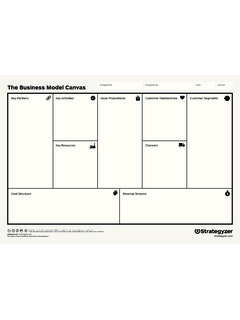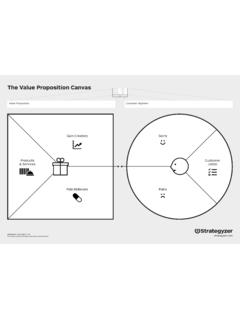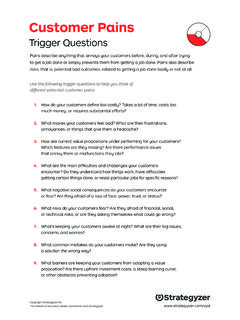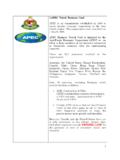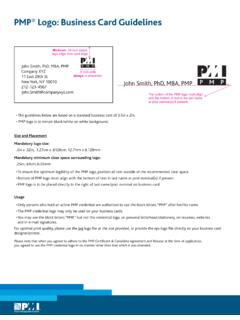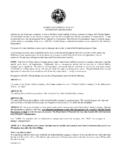Transcription of The Business Model Design Space - Strategyzer
1 The Business Model Design SpaceCard Deck16 ObjectiveThe objective of this workshop exercise is to visualize and map out everything that is going on in your Business Model s environment (the Market Forces, the Key Trends, the Industry Forces, and the Macroeconomic Forces). It is an immersion into the Business Model Design Space , which will help you prepare for your quest for new and innovative Business models. By making it visual you will develop a more tangible understanding of your environment. Ideally you conduct this workshop with a diverse group of people in different functions and from various parts of your organization. The workshop will help you develop a better and shared understanding of what influences your Business Model and it will help you un-cover completely new opportunities and avenues for the development of new and innovative Business A visual map of your Business Model Design Space Deep discussions about your Business Model s environment leading to a shared understanding A starting point to Design innovative Business models or redesign your current one26 Why this is important No individual alone in your organization could paint a holistic picture of your Business Model s environ-ment and Design Space .
2 Only by mapping out each specialist s knowledge you can develop a shared understanding of your environment. A visual map of your Business Model s environment with markets, trends, customer needs, competitors, and more will make things more tangible and it will allow you to uncover new associations, discover new patterns, and ultimately lead to new Business Model ideas. This immersion into the Business Model Design Space is an ideal preparation for the prototyping of innovative Business of workshop participantsApproximately 4-8 people DurationPre-workshop material collection (ongoing) 2-4 hours workshop Post-workshop digestion (ongoing)Material Required A completed Business Model Canvas Poster of your current Business Model (if you are a start-up or if you enter a new market you don t necessarily need that) Large wall where you can stick up material Set of Business Model Design Space cards A collection of material of everything that s going on around your Business Model (news clippings, photos of customer interactions, spreadsheets, print-outs of competitors websites, industry statistics and graphs, etc.)
3 Stattys46 Workshop Instructions 1. Attach the completed Business Model Canvas Poster of your current Business Model to the middle of a large Decide with which one of the four areas you want to start with: Market Forces, Key Trends, Industry Forces or Macro-Economic Draw all the cards of the selected area and stick the first one onto the wall around the Canvas. Market Forces cards go to the right of the Canvas, Key Trend cards go above the Canvas, Industry Forces cards go to the left of the Canvas, and Macro-Economic cards go below the Answer the questions on the card by sticking up and discussing Stattys, photos, spreadsheets, graphs, print outs, products, magazine tear outs, or anything else that is readable , preferably from a distance. Use a lot of visual material rather than just text. 5. Continue with the remaining cards of the selected area and subsequently move to the next area of your choice until you worked through all the Tada!
4 You now have a visual map of your Business Model Design StepsContinue to complete the Business Model Design Space picture after the time to wander the map of the Business Model Design Space to uncover new associations between the different elements in order to develop new Business Model a subsequent workshop to a) brainstorm for innovative Business Model ideas, and b) develop prototypes of a selection of these ideas by mapping them out with the Business Model workshop can also be conducted with four teams of approximately 4-8 people. Each team works on one of the four main areas of your Business Model environ-ment: Market Forces, Key Trends, Industry Forces, and Macro-Economic Trends. Subsequently you assemble the big picture by allowing each team to explain their findings in the Forces Competitors (Incumbents)New entrants (Insurgents)Substitute Products & ServicesStakeholdersSuppliers & other Value Chain ActorsStick these cards on the wall, to the left side of the Business Model Canvas poster.
5 Who are our competitors? Who are the dominant players in our particular sector? What are their competitive advantages or disadvantages? Describe their main offers. Which Customer Segments are they focusing on? What is their Cost Structure? How much influence do they exert on our Customer Segments, Revenue Streams, and margins?Competitors (Incumbents)Identifies incumbent competitors and their relative strengthsIndustry Forces15 Who are the new entrants in your market? How are they different? What competitive advantages or disadvantages do they have? Which barriers must they overcome? What are their Value Propositions? Which Customer Segments are they focused on? What is their cost structure? To what extent do they influence your Customer Segments, Revenue Streams, and margins?New Entrants (Insurgents)Identifies new insurgent players and determines whether they compete with a Business Model different from yoursIndustry Forces25 Which products or services could replace ours?
6 How much do they cost compared to ours? How easy it is for customers to switch to these substitutes? What Business Model traditions do these substitute products stem from ( high-speed trains versus airplanes, mobile phones versus cameras, Skype versus long-distance telephone companies)?Substitute Products and ServicesDescribes potential substitutes for your offers including those from other markets and industriesIndustry Forces35 Which stakeholders might influence your Business Model ? How influential are shareholders? Workers? The government? Lobbyists? StakeholdersSpecifies which actors may influence your organization and Business modelIndustry Forces45 Who are the key players in your industry value chain? To what extent does your Business Model depend on other players? Are peripheral players emerging? Which are most profitable?
7 Suppliers and other Value Chain ActorsDescribes potential substitutes for your offers including those from other markets and industriesIndustry Forces55 Market Forces Market IssuesMarket Segments Needs & DemandsSwitching CostsRevenue AttractivenessStick these cards on the wall, to the right side of the Business Model Canvas poster. What are the crucial issues affecting the customer landscape? Which shifts are underway? Where is the market heading? Market IssuesIdentifies key issues driving and transforming your market from Customer and Offer perspectives15 Market Forces What are the most important Customer Segments? Where is the biggest growth potential? Which segments are declining? Which peripheral segments deserve attention? Market SegmentsIdentifies the major market segments, describes their attractiveness, and seeks to spot new segments25 Market Forces What do customers need?
8 Where are the biggest unsatisfied customer needs? What do customers really want to get done? Where is demand increasing? Declining? Needs & DemandsOutlines market needs and analyzes how well they are served35 Market Forces What binds customers to a company and its offer? What switching costs prevent custom-ers from defecting to competitors? Is it easy for customers to find and purchase similar offers? How important is brand? Switching CostsDescribes elements related to customers switching Business to competitors45 Market Forces What are customers really willing to pay for? Where can the largest margins be achieved? Can customers easily find and purchase cheaper products and services?Revenue AttractivenessIdentifies elements related to revenue attractiveness and pricing power55 Market ForcesKey TrendsTechnology TrendsRegulatory Trends Societal & Cultural TrendsSocioeconomic Trends Stick these cards on the wall, to the top side of the Business Model Canvas poster.
9 What are the major technology trends both inside and outside your market? Which technologies represent important opportunities or disruptive threats? Which emerging technologies are peripheral customers adopting? Technology TrendsIdentifies technology trends that could threaten your Business Model or enable it to evolve or improve14 Key Trends Which regulatory trends influence your market? What rules may affect your Business Model ? Which regulations and taxes affect customer demand? Regulatory TrendsDescribes regulations and regulatory trends that influence your Business model24 Key Trends What are the key demographic trends? How would you characterize income and wealth distribution in your market? How high are disposable incomes? Describe spending patterns in your market ( housing, healthcare, entertainment, etc.)
10 ? What portion of the population lives in urban areas as opposed to rural settings?Socioeconomic TrendsOutlines major socioeconomic trends relevant to your Business model34 Key Trends Describe key societal trends. Which shifts in cultural or societal values affect your Business Model ? Which trends might influence buyer behavior? Societal and Cultural TrendsIdentifies major societal trends that may influence your Business model44 Key TrendsMacro Economic ForcesGlobal Market ConditionsCapital Markets Commodities and Other ResourcesEconomic Infrastructure Stick these cards on the wall, to the bottom side of the Business Model Canvas poster. Is the economy in a boom or bust phase? Describe general market sentiment. What is the GDP growth rate? How high is the unemployment rate?Global Market ConditionsOutlines current overall conditions from a macroeconomic perspective14 Macro Economic Forces What is the state of the capital markets?



